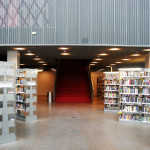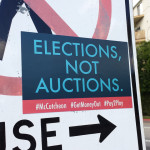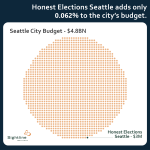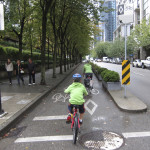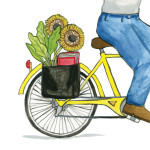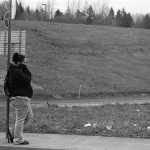Search Results
-
Weekend Reading 1/15/16
Anna We’ve written before about the sustainability genius of libraries (public libraries are one of Sightline’s Seven Wonders of Sustainability). And beyond books, there’s a growing trend toward community tool libraries (also brilliant). There’s no reason even a fraction of households in a city should invest in a tool they’ll use once or twice, a tile cutter, say, or even necessarily a lawn mower! And toy libraries make total sense,...Read more » -
Honest Elections Seattle Bans “Pay to Play”
In 2013, when then-state senator Ed Murray was running for mayor of Seattle, his campaign asked Microsoft for the maximum allowed political contribution, which was $700 that year, and the company obliged. Murray was not alone in benefiting from Microsoft’s largesse: the software maker distributed similar contributions to a bevy of candidates that year and in the years since: $4,600 in the 2013 and 2015 elections combined, making it one...Read more » -
Honest Elections Seattle Tames Lobbying Money
In 2013, during the last municipal election campaigns in Seattle, the ridesharing company Lyft was fighting for its life in a dispute over local taxi regulations. It contributed $2,600 to candidates for mayor and city council and also spent $15,000 lobbying city hall. Eventually, it won city rules agreeable to its interests. Meanwhile, Clise Properties, a developer involved in an enormous set of construction projects north of downtown Seattle for...Read more » -
Charts: Honest Elections Seattle is an Incredible Bargain
Honest Elections Seattle, the citizens’ initiative to hold elected officials accountable and give ordinary voters a stronger voice in local elections, is financed by a special property tax levy of $3 million per year. To you or me, that may sound like a lot of money. For a city like Seattle, though, it’s “budget dust,” in the words of Bill Finkbeiner, former Republican leader of the Washington State Senate. Seattle’s...Read more » -
Photo Essay: A Family’s Vancouver Bicycle Cruise

Riding in a cycle lane in Vancouver, BC. by Alyse Nelson used under CC BY-NC 2.0 (Used with permission.)
When my husband Jason and I planned a trip to Vancouver, BC, we decided to bring our family’s bikes just in case. With our eight-year-old son Orion in tow, I wasn’t sure we’d have the chance to ride unless we sought out an off-street trail. To my surprise, we were able to ride—and not just on trails we had to drive or take a bus to, but through the heart...Read more » -
The Top 14 of 2014
2014 was a big year for Sightline, inside and out. We took deeper dives into family-friendly urban policy, money’s influence on our democracy, and making polluters pay for their carbon pollution. We also continued our leading research on coal and oil exports out of Cascadia; traffic trends, transit funding, and rideshare safeguards; and a number of other key topics for promoting sustainability across the Northwest. And you, dear reader, you dove...Read more » -
Weekend Reading 9/19/14
Serena Don’t forget to visit your city’s PARK(ing) Day installations TODAY! (I’m dying to stop by Seattle Met‘s SwaPark.) Here are listings for Seattle, but I’m having trouble finding them for Portland, Vancouver, Eugene, Spokane, Olympia, Salem, Burnaby… others? If you have links, share ’em! Better yet, if you visit one today, snap a photo and send it to me! Alan Three think pieces this week: Should we aim to...Read more » -
3 Charts: Bus Cuts Drive Riders Away
Seattle recently got accolades for being one of the US cities with significant growth in transit ridership. This mirrors a national trend in which more people rode buses, trains, streetcars and subways last year than at any time since 1956. A good part of that bump came from Sound Transit. But King County Metro’s bus ridership also grew by 3 percent last year, and it has nearly reached the record...Read more » -
Declining Traffic Through Seattle
Last week, I wrote about the surprising (and largely unheralded) decline in vehicle traffic on Seattle's Alaskan Way Viaduct in 2012. That's when the state demolished the south end of the structure, shunting vehicles through a set of hairpin turns that can back up traffic, particularly during rush hour. Because of the delays, many drivers now avoid the route. Surprisingly little of the traffic that "disappeared" from the Viaduct moved to parallel routes. City streets near the Viaduct saw a slight uptick in traffic. So did I-5. But on the whole, traffic through downtown declined sharply after Viaduct construction began. But even more surprisingly, the declines of 2012 merely accelerated a longstanding trend. According to data from the Washington and Seattle departments of transportation, traffic through downtown Seattle actually peaked all the way back in 1998, and has declined steadily since then.
Last week, I wrote about the surprising (and largely unheralded) decline in vehicle traffic on Seattle’s Alaskan Way Viaduct in 2012. That’s when the state demolished the south end of the structure, shunting vehicles through a set of hairpin turns that can back up traffic, particularly during rush hour. Because of the delays, many drivers now avoid the route. Surprisingly little of the traffic that “disappeared” from the Viaduct moved...Read more » -
Bertha vs. The Bus
In a few months, King County voters will be asked to invest in the future of our local roads and bus system. In particular, Metro needs additional revenue to avoid crippling cuts to its transit system. Just a few years ago, Seattle voters had another opportunity to support local roads and buses. Instead of investing in changes to make local streets and transit function without the Alaskan Way Viaduct, voters...Read more »

